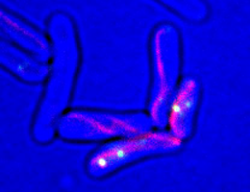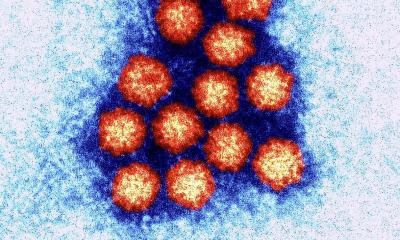Bacterial viruses
Tools of the trade
LMU researchers demonstrate for the first time that bacteriophages (bacterial viruses) carry genetic instructions for proteins that mediate the transport of their DNA to specialized replication sites in the host cell.

Viruses are essentially inert nucleoprotein particles that come alive only when they find the right host cells, on which they depend for their reproduction. Bacteriophages (or ‘phages’ for short) are viruses that infect bacteria. Work carried out by researchers led by Marc Bramkamp, who is Professor of Microbiology at LMU, and Professor Julia Frunzke at the Jülich Research Center now shows that some bacteriophages deliver certain proteins required for optimal replication of their own genomes to host cells that do not themselves possess them. The new findings appear in the journal “Nucleic Acids Research”.
“In order to replicate their own hereditary material, viruses must ensure that it reaches the sites of DNA replication that are normally utilized by the host and the correct egress sites where the viruses leave the host. We have now shown, for the first time, how a so-called prophage (a viral DNA that has been integrated into the genome of its host during a prior infection) organizes its own transport to such a replication site when induced to self-excise from the bacterial chromosome,” Marc Bramkamp explains.
Viruses that infect the nucleated cells of higher organisms (eukaryotes) often exploit the so-called actin cytoskeleton, a complex system of metastable fiber-like structures (filaments) for this purpose. The cytoskeleton then delivers the viral DNA to the replication machinery in the nucleus of the host cell. Bacterial cells do not have a nucleus, but it has become clear in recent that some species of bacteria possess a cytoskeleton, which is in fact made up of a protein that is related to the actin of eukaryotes. Bramkamp, Frunzke and their co-workers have now shown that an actin-like protein plays a role in the replication of the DNA of a bacteriophage found in a so-called corynebacterium.
Walking the tracks
The species chosen for study by the LMU researchers was Corynebacterium glutamicum, which lacks a cytoskeleton. “We found, however, that the integrated prophage contained a gene for an actin-like structural protein, and inferred that it might be involved in the intracellular transport of the viral DNA,” Bramkamp says. In other words, the virus itself carries the tools for the construction of an intracellular transport system in its luggage, as it were.
Bramkamp and colleagues then went on to elucidate the molecular mechanism underlying the transport of the viral DNA. The genetic instructions for the production of an actin-like protein reside in a gene they call AlpC. “It is one of the first viral genes to be transcribed when the integrated prophage is experimentally reactivated,” says Bramkamp. Reactivation leads to the excision of the viral DNA, which then is linked to an adapter protein, AlpA. This complex in turn attaches to actin-like filaments made up of AlpC. “The viral DNA then moves along the filament from one AlpC subunit to the next, like someone stepping out along a path,” Bramkamp explains. The adapter protein is responsible for the control of filament dynamics. “The resulting cycles of assembly and disassembly of the filaments determine the direction of movement of their DNA cargo.” The viral DNA’s destination is most probably the cell membrane, where replication and virus assembly then take place.
“Our work shows for the first time that the interaction between viruses and the cytoskeleton is an evolutionarily ancient process,” Bramkamp points out. “It might even be the case that bacteria which have their own actin-like cytoskeleton originally obtained the necessary genes from viruses,” He adds the researchers now want to look at other phages to find out more about how intracellular transport works in virus-infected bacteria.
(Nucleic Acids Research, doi: 10.1093/nar/gkv374)
Source: LMU
08.05.2015











